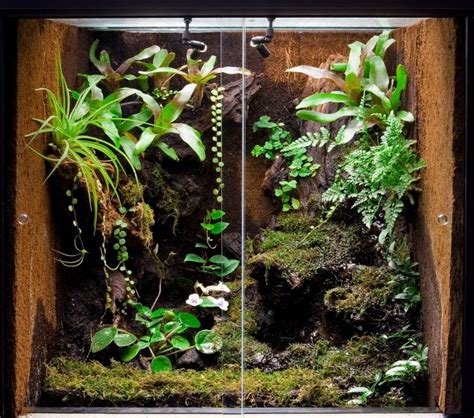Introduction
Bioactive terrariums have emerged as captivating ecosystems that mirror the intricate balance found in nature. By incorporating live plants, invertebrates, and substrate that mimics the natural soil composition, these terrariums not only provide a stunning aesthetic but also offer a unique opportunity to observe the interconnectedness of living organisms. In this comprehensive guide, we delve into the fascinating world of bioactive terrarium decoration, exploring the essential elements and innovative techniques to create thriving ecosystems for your cherished reptiles and amphibians.

The Role of Live Plants
Live plants are the cornerstone of any bioactive terrarium, serving multiple crucial functions:
- Photosynthesis: Plants absorb sunlight and convert it into energy through the process of photosynthesis, releasing oxygen as a byproduct. This oxygen is vital for the respiration of terrarium inhabitants and beneficial microorganisms.
- Air Filtration: Plants effectively remove harmful pollutants and excess carbon dioxide from the air, creating a healthier environment for terrarium occupants.
- Humidity Regulation: Plants transpire water vapor into the air, maintaining the humidity levels necessary for many reptile and amphibian species.
- Shelter and Hiding Places: Plants provide ample hiding places and basking spots for animals, allowing them to feel secure and engage in natural behaviors.
Selecting Appropriate Plant Species
Choosing the right plant species for your bioactive terrarium is essential for its long-term success. Consider the following factors:
- Hardiness: Opt for plants that are tolerant of the terrarium’s humidity and temperature fluctuations.
- Growth Habits: Select plants that will not overgrow or compete with each other for space and resources.
- Toxicity: Avoid plants that are toxic to your chosen terrarium species.
- Benefits: Choose plants that offer specific benefits to your animals, such as providing nectar for feeders or attracting beneficial insects.
Creating the Perfect Substrate
The substrate, the foundation of the terrarium’s ecosystem, plays a critical role in providing drainage, retaining moisture, and supporting beneficial microorganisms. For bioactive terrariums, a mix of organic materials that mimic natural soil composition is recommended:
- Coco Coir: This moisture-retentive material is derived from coconut husks and provides excellent drainage.
- Orchird Bark: The porous bark pieces contribute to aeration and drainage while providing anchor points for plant roots.
- Leaf Litter: Decaying leaves provide a food source for microorganisms and help regulate humidity.
- Activated Charcoal: This material absorbs impurities and reduces odors in the substrate.
Enhancing Bioactivity with Invertebrates
Invertebrates, such as springtails and isopods, are crucial for maintaining a healthy bioactive terrarium. These tiny creatures break down organic matter, consume mold, and aerate the substrate, promoting a balanced ecosystem:
- Springtails: These small, jumping insects decompose organic matter and waste, preventing the accumulation of harmful bacteria.
- Isopods: These larger crustaceans feed on decaying plant material and help aerate the substrate through their burrowing activity.
Effective Strategies for Bioactive Terrarium Decoration
To create a thriving bioactive terrarium, implement the following effective strategies:
- Planning: Plan the terrarium layout carefully, ensuring adequate space for plants, animals, and substrate.
- Quarantine: Quarantine new plants and animals before introducing them to the terrarium to prevent the spread of diseases or pests.
- Maintenance: Regularly mist the terrarium to maintain humidity, clean up waste, and trim overgrown plants.
- Monitoring: Monitor the terrarium regularly for signs of stress or disease in plants or animals and adjust conditions as needed.
Showcase of Stunning Bioactive Terrarium Decorations
1. Lush Amazonian Rainforest: Create a vibrant ecosystem inspired by the Amazonian rainforest, featuring lush ferns, bromeliads, and epiphytes perched on driftwood and vine-covered logs.
2. Desert Oasis: Replicate the arid landscapes of the desert with drought-tolerant plants such as cacti, succulents, and agaves, coupled with a sandy substrate dotted with rocks and weathered wood.
3. Tropical Paradise: Design a tropical paradise for your exotic frogs and geckos, featuring cascading waterfalls, vibrant bromeliads, and a backdrop of cork bark and bamboo.
4. Paludarium Paradise: Combine the beauty of a terrarium and an aquarium in a paludarium, creating a partially submerged environment with aquatic plants, overhanging vines, and a basking area for semi-aquatic species.
Standing Out with Unique Bioactive Terrarium Decorations
To make your bioactive terrarium stand out, consider implementing these innovative ideas:
- Incorporate Vertical Elements: Utilize vertical structures such as driftwood or cork bark to create additional climbing and hiding spaces for animals.
- Experiment with Live Moss: Introduce live moss as a carpet or on vertical surfaces, adding a lush and vibrant touch to the terrarium.
- Create a Custom Background: Design a custom background with paint, cork bark, or photographic prints to enhance the visual appeal of the terrarium.
- Add Unique Hardscapes: Explore the use of unusual hardscapes, such as shattered pottery or reclaimed wood, to create a distinct and personalized terrarium decoration.
Reviews of Bioactive Terrarium Decoration Products
1. Exo Terra Bioactive Terrarium Substrate Kit: A comprehensive kit that includes all essential substrate components for bioactive terrariums.
2. Nature’s Way Terrarium Plants: A curated selection of live plants specifically chosen for their suitability in bioactive terrariums.
3. Springtail and Isopod Cultures: Starter cultures of springtails and isopods to kickstart the decomposition process in your terrarium.
4. BioDude TerraFlora Advanced Soil Substrate: A premium substrate mix designed to promote plant growth and microbial activity in bioactive terrariums.
Conclusion
Bioactive terrarium decoration is an art form that combines creativity with a deep understanding of the interconnectedness of living organisms. By incorporating live plants, invertebrates, and a carefully crafted substrate, you can create a thriving ecosystem that provides countless hours of enjoyment and fascination. Remember to plan, quarantine, maintain, and monitor your terrarium, and don’t hesitate to experiment with unique ideas to make your creation truly stand out. As the popularity of bioactive terrariums continues to grow, embrace the opportunity to bring a piece of nature into your home, inspiring wonder and fostering a connection with the natural world.





















